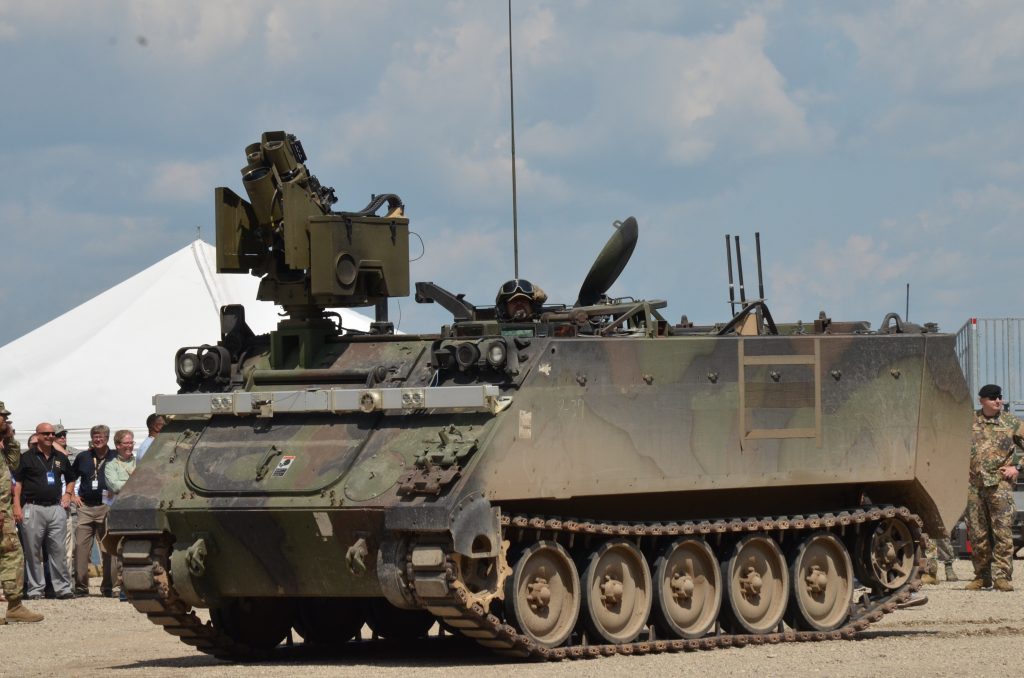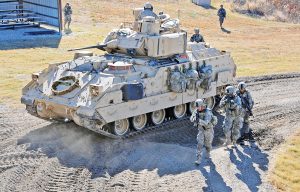
Experimental robotic M113 armored vehicle (with human monitor aboard for safety) at Camp Grayling in 2017
WASHINGTON: What does it take to build a tank? You’d probably think of guns, armor, big engines — not wireless chargers or intellectual property rights. But Bruce Jette does think about those things, which is why he’s the head of Army acquisition. The first real test of his new IP policy: the Army’s high-tech Next Generation Combat Vehicle.
The NGCV project, the Army’s No. 2 modernization priority, is developing multiple manned and robotic vehicles. The most urgent effort: replacing the venerable M2 Bradley troop carrier with a new Optionally Manned Fighting Vehicle that can carry infantry into future battles with better protection, more firepower, and a host of electronic sensors, from mini-drones to an artificially intelligent targeting assistant called ATLAS. They also want the option to run the vehicle by remote control or, in the longer term, with an onboard AI.
But OMFV is only one piece of the Army’s massive modernization drive, and all those pieces have to work together, Jette pointed out at the McAleese/Credit Suisse conference this week.
When soldiers jump onboard the vehicle, for example, why not have it immediately start recharging all their electronics — radios, targeting scopes, the new IVAS augmented-reality goggles, etc. — using wireless inductive chargers? “You sit in the seat, boom! you’re charging,” said Jette, who uses one such system for his own phone.
The soldiers’ IVAS displays should also connect to the OMFV’s own network to share data, like reconnaissance imagery from the vehicle’s mini-drones. Does that require building a wireless Local Area Network (LAN) inside the OMFV? It’s doable, Jette said, and it can even be made secure. But you need to get all the data-sharing protocols worked out well in advance, then get multiple programs and contractors to comply. That’s part of why Jette has created a Chief Systems Engineer position. (The relevant staff come from, ironically, a vestigial remnant of the long-since-cancelled Future Combat Systems, which had 18 different technologies to connect).
But you don’t just need to get multiple contractors — OMFV, IVAS, radios, network routers — all working together: They’re also all competing with each other, which makes them mighty touchy about protecting their intellectual property.
In fact, Jette said, companies don’t even like to make formal comments on RFPs and Requests For Information, because all those comments are made public allowing their competitors to see what they’re thinking about. (Jette said he’s trying to change this but it turns out to be legally very hard). Companies get outright livid if the government actually gives away their intellectual property — whether intentionally or not. After all, it can be a fatal blow for smaller firms.
So how does the government share enough detail to get everyone to work together, without divulging too much and giving away trade secrets? That’s the tightrope Jette walks in a new intellectual property policy Army Secretary Mark Esper approved Dec. 7.
Guidance on how to implement the new policy is still a work in progress — it feels like it’s being “reviewed 10,000 times,” Jette sighed — but will be ready in time to use the OMFV program as the first test case.
The Office of the Secretary of Defense is considering using the new Army IP policy as a template for the other services, although Jette said the Navy and Air Force were likely to add additional restrictions.
In the new Army IP policy, “it doesn’t say we want to own everything, it just says we want to have access to everything that defines what we’re doing [e.g. interfaces]. The other services are a little bit more interested in having a little bit tighter position.”
For someone so detail-oriented, in fact, Jette is remarkably willing to cede control. In recent years, Congress decentralized a lot of acquisition decision-making to the services, and Jette says he’s been busy delegating further. By law, he personally must make the key decisions on the biggest programs, Acquisition Category (ACAT) I — basically, anything with a total R&D cost over $480 million — but everything smaller, he said, “I’m not going to retain any of them.” The Army’s even stooped to copying the Navy by creating a new category, ACAT IV, that lets Jette delegate control of the smallest programs to colonels or lieutenant colonels.
Jette also plans to decentralize Army contracting by giving major commands more in-house contracting expertise. And he’s pruned a library of over 250 acquisition policies down to 82. Actually, he got it all the way down to 54 at one point, Jette said, but the number crept back up.
One area where Jette is not going full-bore? The new Section 804 “middle-tier acquisition” authorities created by Congress. The Army’s definitely using the new streamlined procedure. It’s got eight Section 804 programs in progress, including the IVAS augmented reality targeting goggles. But while Air Force acquisition chief Will Roper seems to feel that programs do best as 804s unless proven otherwise, Jette said, he prefers that Army programs prove they specifically could benefit from 804 status.
That doesn’t mean following the standard process blindly, said Jette, which can lead to review upon review and requirement upon requirement until you get — to take his favorite example of an over-spec’d Army system — “a 12-pound iPad.” But you can avoid that without completely jettisoning the standard process and going all the way to Section 804, Jette said, if you use some often-overlooked but perfectly legitimate waivers to bypass bureaucratic hurdles.
Jette has also overhauled the Army’s Rapid Capabilities Office, which was modeled on an Air Force initiative to accelerate critical high-tech projects but implemented in ways that meant “it wasn’t really functional.”
The reorganized and renamed Rapid Capability & Critical Technologies Office — “I thought it was a goofy name until I realized it was my boss who named it” — will take over three top-priority technologies to start modernization: hypersonic weapons, directed energy (lasers), and space programs. It’ll operate much like a standard Program Executive Office, Jette said, except its head will be a three-star general, higher than any other PEO in the Army, with direct access to top Army leaders, working on the most critical technologies for modernization.
‘AI-BOM’ bombs: Army backs off, will demand less detailed data from AI vendors
Instead of demanding an exhaustive “AI Bill of Materials.” the Army will only ask contractors for a “baseball card” of key stats on their AI — while building up its in-house capacity to check for bad code or “poisoned” data.




























